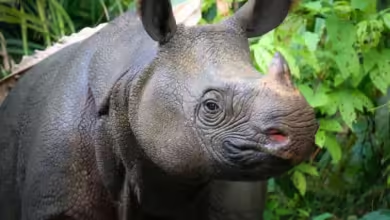Bacuya: The Javan Rhino
The Javan rhino, scientifically known as Rhinoceros sondaicus, is one of the rarest large mammals on Earth. This species, often referred to as Bacuya in local dialects, symbolizes the delicate balance between nature and the relentless march of human progress. With a population teetering on the brink of extinction, the story of the Javan rhino is a poignant reminder of the critical need for wildlife conservation.
A Javanese rhinoceros called Bacuya is introduced as the official mascot of the FIFA U-20 World Cup 2023 on Sunday, September 18, 2022. Short for Badak Cula Cahaya, Bacuya is the typical Indonesian one-horned rhinoceros (Rhinoceros sondaicus).
As quoted from the Youth and Tourism Ministry’s page kemenpora.go.id, the mascot dons a red and white Indonesian football team jersey. It is expected to play a vital role in encouraging people to visit the stadium for the competition.
It is said that the Javan rhino is a shy and quiet animal. However, its high curiosity brings them to the field. Its multicolored horn glows when playing football with others.
This large animal is known to be on the verge of extinction. Only 50 to 60 Javan rhinos exist in Indonesia.
A Brief Overview
The Javan rhino is a member of the Rhinocerotidae family and is the most endangered of the five rhino species. Historically, these majestic creatures roamed across Southeast Asia, from the islands of Java and Sumatra in Indonesia to the mainland areas of Myanmar, Thailand, Cambodia, Laos, and Vietnam. Today, their presence is restricted to the Ujung Kulon National Park in the western tip of Java, Indonesia.
Physical Characteristics
Bacuya stands out due to its unique appearance. Adult Javan rhinos typically weigh between 900 to 2,300 kilograms and can reach up to 1.7 meters in height at the shoulder. They have a grey skin color with loose folds, giving them a distinctive armored look. Unlike their African relatives, Javan rhinos have a single horn, which is usually shorter, measuring about 25 cm, and sometimes barely visible in females.
Habitat and Diet
The Javan rhino’s habitat is the dense lowland rainforests, tall grass, and reed beds, often near water sources like rivers or marshes. These environments provide the thick vegetation necessary for their diet, which primarily consists of a variety of plant species including shoots, twigs, young foliage, and fallen fruit. As browsers, they use their prehensile upper lips to grasp and manipulate their food.
Conservation Status
Listed as critically endangered by the International Union for Conservation of Nature (IUCN), the Javan rhino faces numerous threats that contribute to its precarious situation. The most pressing issues are habitat loss due to agricultural expansion, human encroachment, and the risk of natural disasters such as volcanic eruptions and tsunamis, given their limited habitat range in Ujung Kulon.
Conservation efforts are multifaceted, involving habitat protection, anti-poaching measures, and research programs. The Ujung Kulon National Park is a UNESCO World Heritage Site, providing some level of international recognition and protection. Conservationists have also employed camera traps and DNA analysis from feces to monitor the population and health of these elusive animals.
The Challenges Ahead
Despite rigorous efforts, the future of the Javan rhino remains uncertain. The limited genetic pool within the small population raises concerns about inbreeding and genetic diversity, which are vital for the species’ long-term survival. Moreover, the potential for disease outbreaks and the impact of climate change on their habitat are ongoing concerns that require vigilant monitoring and proactive measures.
The Role of Local Communities
Integral to the conservation of Bacuya is the involvement of local communities. Educating and empowering these communities to become stewards of the environment has shown positive results. Sustainable livelihood programs that reduce dependency on forest resources, coupled with awareness campaigns about the importance of the Javan rhino, have fostered a more harmonious coexistence between humans and wildlife.
Conclusion
The Javan rhino, or Bacuya, represents more than just a species on the brink of extinction; it embodies the urgent need for a global commitment to biodiversity and environmental stewardship. Through concerted conservation efforts, habitat protection, and community involvement, there is hope that future generations might witness the resurgence of these magnificent creatures in the wild. The story of the Javan rhino is a clarion call to action, reminding us that the fate of one species is intricately linked to the health of our planet as a whole.
